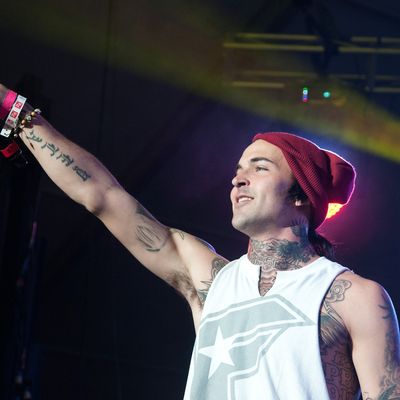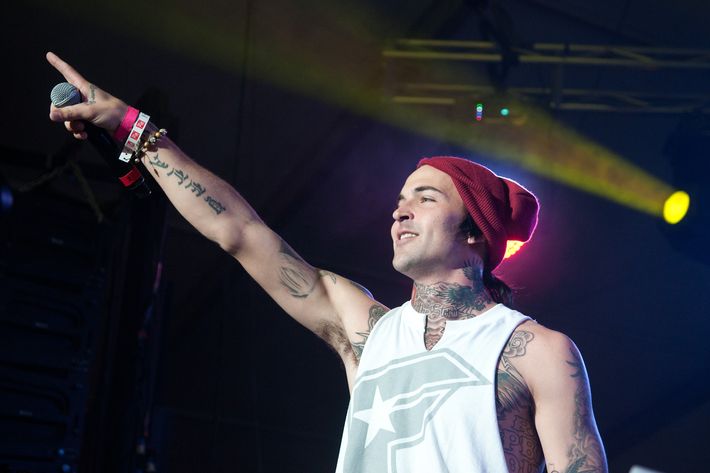

The first SXSW event I attended on Wednesday was a panel discussion (“Eight Things Hip-Hop Taught America”) prompted by Dan Charnas’s monster new book about the business history of hip-hop (The Big Payback) three veterans of hip-hop press and promotion marveling at this unlikely thing they were a part of, the way a black genre became the dominant sound of pop music in a way that actually generated wealth and power for black artists and entrepreneurs. (Lest anyone take that for granted, Charnas has an amusing bounty of evidence underlining exactly how massive a development this was.) One of the last events I stumbled through on Wednesday due, I swear, to accidentally writing down the wrong venue for something else I meant to see was the beginning of a set by Mac Miller, a 19-year-old white rapper from Pittsburgh who feels like a character on a WB teen drama, was picked as one of this year’s XXL “freshman class,” and will surely be much-loved on plenty of college campuses. This seemed like a fascinating endpoint to nearly everything discussed on that panel hip-hop as a black-American export that’s reshaped the entire country’s culture in ways so deep that they are, to younger people, completely invisible. There’s almost a kind of whiplash to going from a conversation about hip-hop’s fight for radio play to watching college guys shout along with Miller.
Earlier that afternoon, at the artfully ramshackle “FADER FORT by FIAT” — that last part’s a car sponsorship, though I like how it sounds as if The Fader is just really pleased it can have a fort if it damn well decrees it — Welsh trio The Joy Formidable sounded good enough that two different latecomers leaned over to ask me who they are. Live and on record, they start off sounding like 90s alt-rock — glossy and anthemic, as if they’re always on the verge of launching into a Smashing Pumpkins cover — but wind up skewing into something heavier, more modern, and more pop. And singer Ritzy Bryan’s great to watch: She gets ever more big-eyed and manic as the set proceeds. The Brooklyn group Twin Shadow trotted out its rich and boundless love of the years 1985-1987, and the Cure in particular. But the main draw was Alabama rapper Yelawolf, who I’ve never managed to see live before. His presence and personality are seriously compelling and fully unique to him, a vision of the rapper as intense white skater kid — he’s lithe, live-wire, and edgy, and his rhymes are too full of staccato double-time tricks for him to be anything but crisp and focused when he’s on stage.
After sunset, Time Out North America had an official showcase on the big outdoor stage at Stubb’s. For a moment, this felt like it might be the wrong time to see English singer/producer James Blake, whose music is extraordinarily spacious and deliberate — he’ll be playing in a church Thursday night, which seems like it could be a much better setting for his textural experiments and tint of gospel. But no, this stuff sounds terrific in the open air with a good breeze blowing. A lot of the things people disliked about Blake’s much-hyped LP — the stillness of it, the sense that it was too cerebral, the sense that it was all about process — melt away a little when you watch how fluidly his three-piece group actually plays the songs, constructing, in real time, things that can feel like studio embellishments on record.
The funny thing about Time Out’s showcase is how segmented it is in terms of age. Blake, the slack rock band Yuck, the scrappy Chicago power-pop act Smith Westerns — all of them are right around drinking age. (Note: “I’m so tired of being described as ‘bratty’ or, like ‘scrappy,’” one of the Smith Westerns told Spin — “If we were a bunch of fucking ‘tards, we wouldn’t be doing what we’re doing at the level we’re on.” But what would you call that response other than “scrappy?”) But the night took a big leap in age after that: Duran Duran headlined, and before them came veteran soul singer Raphael Saadiq. I like Saadiq; I like his vintage soul vibes; but there’s something about his latest material that feels just a touch too self-consciously dusty and retro. (Or maybe it’s just that the market for that sort of thing feels oversaturated at the moment.) His upcoming LP Stone Rollin’ is an homage to early rock’n’roll and soul, and his touring band does a great, energetic job of selling it — it’s loose and rangy, as opposed to the twitchy, exacting tightness you’d get from, say, Sharon Jones and the Dap-Kings. But at times you get the feeling that if the people on stage were a couple decades older, this would have the slightest whiff of a PBS stage revue.
This showcase isn’t the only thing that poses funny questions about age: There will be official panels, later this week, with titles like “I’m Not Old, Your Music Does Suck” (entertaining the possibility that there are reasons besides old-person grumpiness to feel like music has gotten worse) and “Hip-Hop Crossroads: Growing Up or Getting Old?,” organized by the writer Dream Hampton. One of the interesting things about Charnas’s panel was the sense that, for a couple decades, everyone involved in hip-hop took pride in watching it grow and succeed, seeing it as a cultural victory (and often a racial one) every time the music seized more respect. But if that battle is pretty much won, then what happens next? Does hip-hop become just another genre, or a static, moribund thing instead of a vital “nation?” This is a really specific anxiety Hampton’s panel will be confronting — the anxiety, basically, that hip-hop will become anything like rock.

